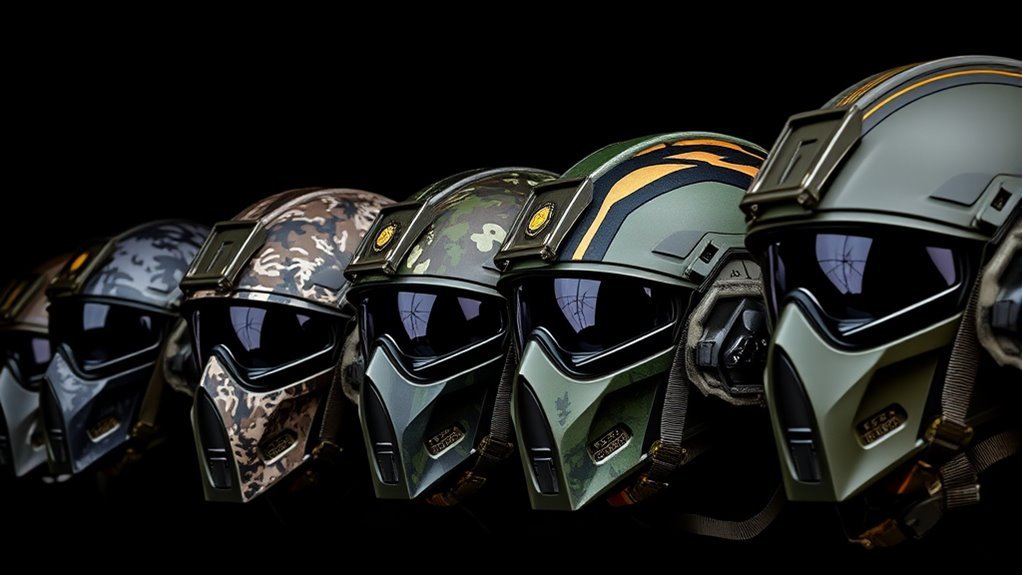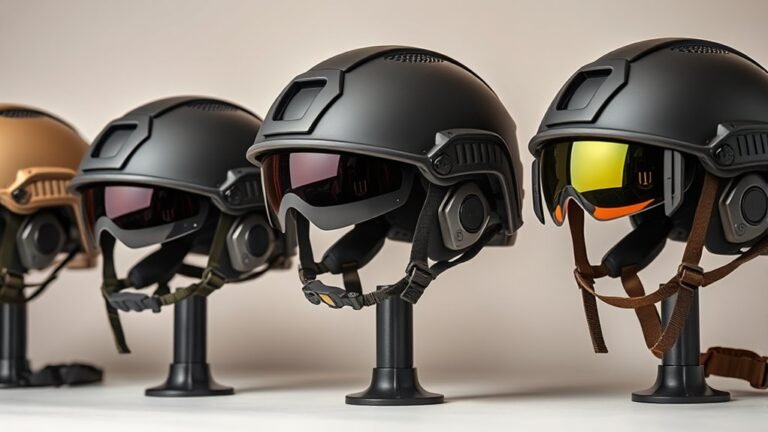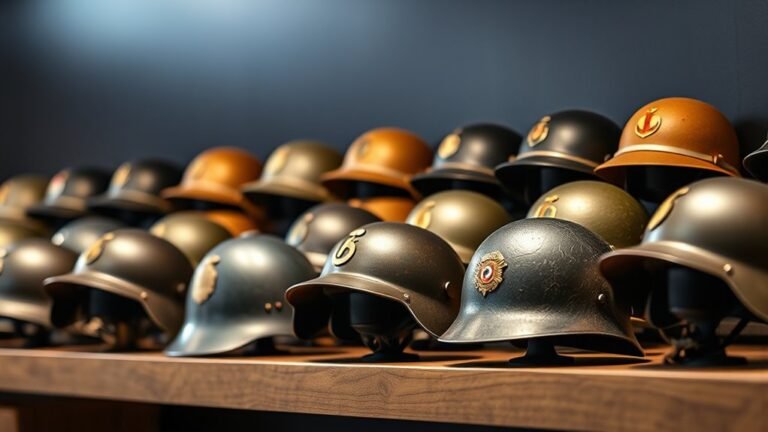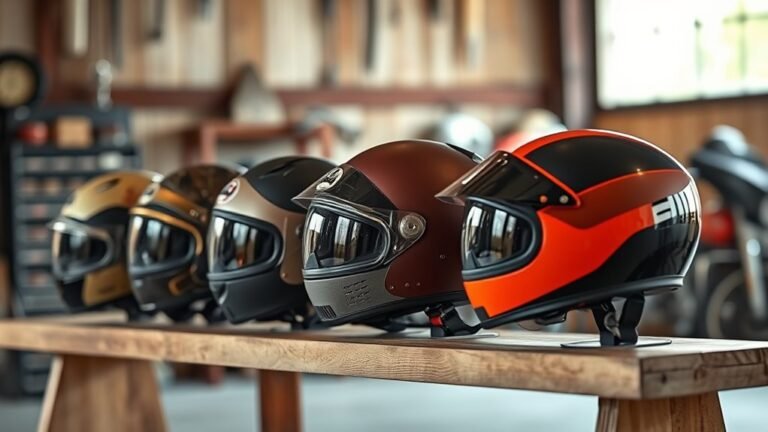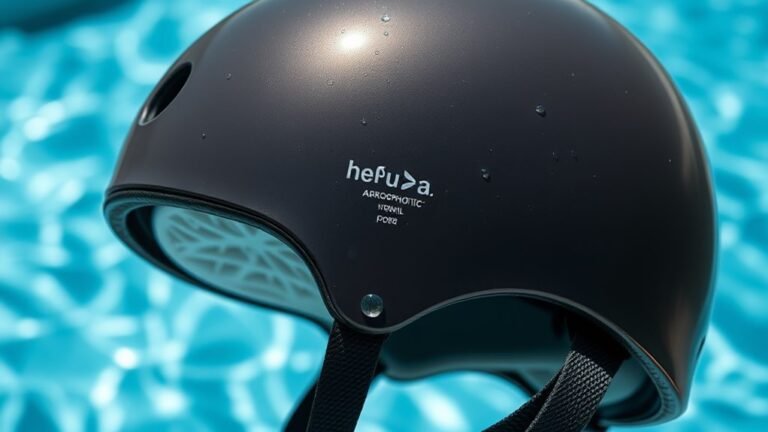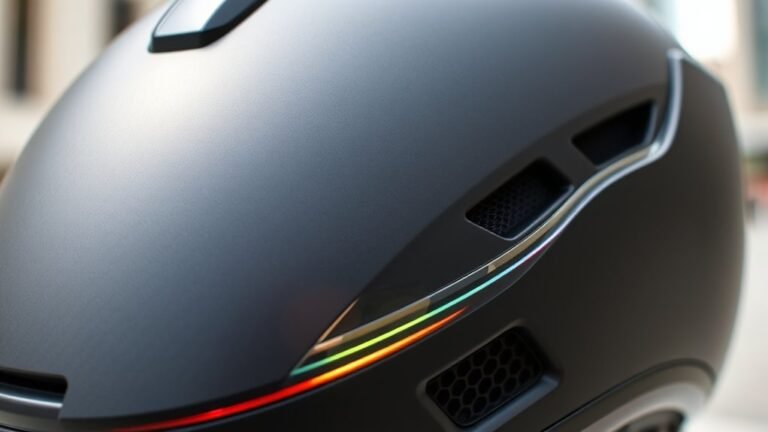Special Forces Helmet Designs Explained
Special forces helmets are designed for maximum protection and functionality in combat. They incorporate advanced materials for lightweight ballistic resistance, with ratings tailored for various threats. Integrated communication systems guarantee seamless coordination while night vision and augmented reality technologies enhance situational awareness. Customizable modular designs allow for adaptability in diverse environments, promoting peak performance. With unique features tailored to operational needs, you’ll discover even more about these intricate designs and their functionalities.
Historical Evolution of Special Forces Helmets
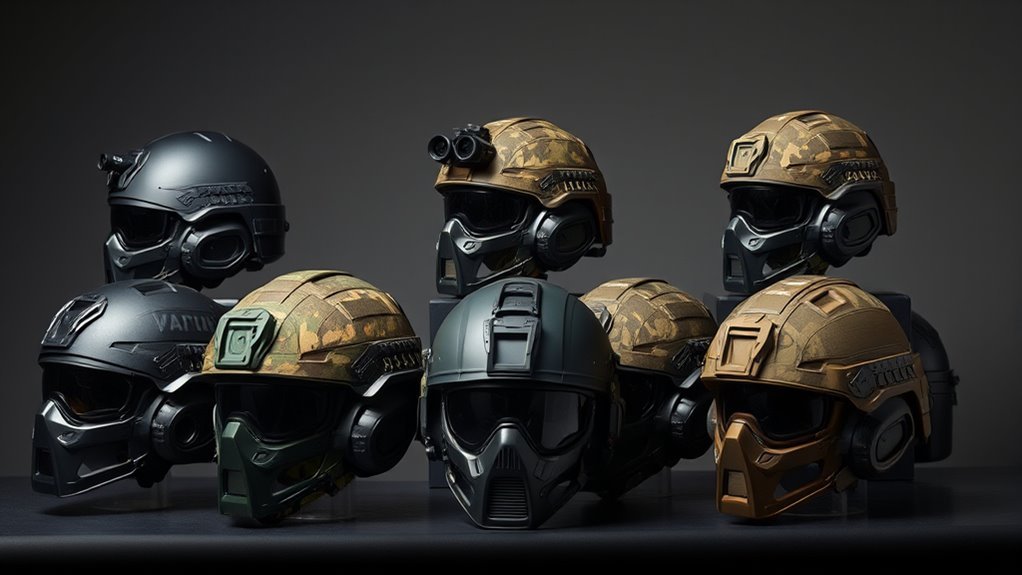
As the needs of modern warfare evolved, so did the design of special forces helmets, which have become essential for both protection and functionality. Tracking the historical significance of these helmets reveals how design influences stem from various combat environments and technological advancements. Early models focused on basic head protection, often incorporating materials like steel. However, as unconventional warfare emerged, helmets transformed to include features such as ballistic protection, night vision mounts, and communication systems. Each evolution was driven by the requirement for enhanced situational awareness and adaptability in dynamic combat scenarios. By understanding this historical trajectory, you can appreciate how modern special forces helmets are tailored to meet the demands of freedom-seeking operatives in an ever-changing battlefield landscape.
Key Materials Used in Helmet Construction
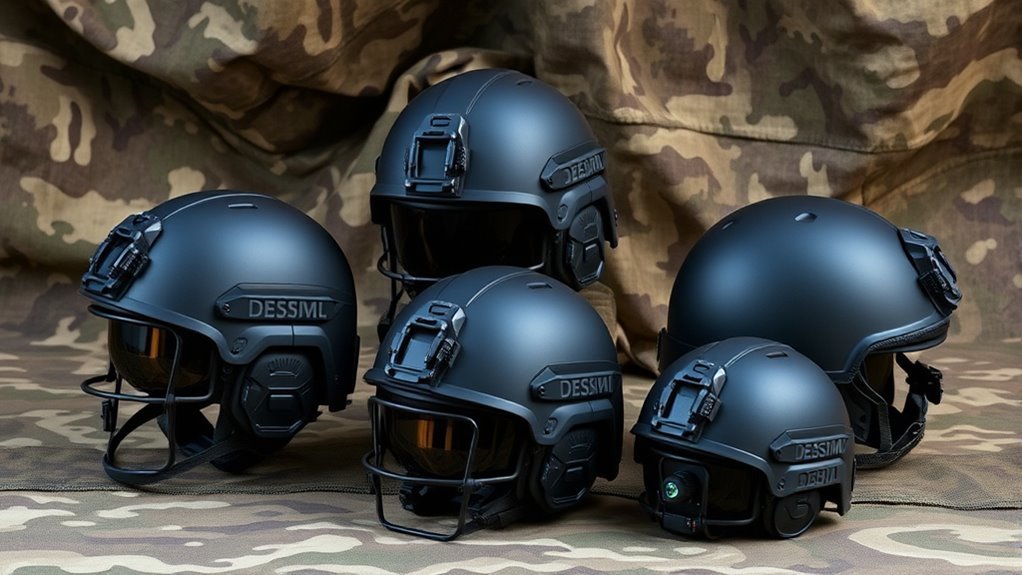
Modern special forces helmets utilize a range of advanced materials that enhance performance and safety. One key component is composite materials, which combine various elements to achieve superior strength without adding excessive weight. These materials are engineered to provide ideal impact resistance, essential for protecting against blunt force trauma during operations.
Additionally, some helmets incorporate aramid fibers, known for their high tensile strength and durability, further boosting safety. The integration of these advanced composites allows helmets to maintain a low profile while delivering fundamental protection.
In your pursuit of freedom, understanding the materials that safeguard your tactical gear is critical. By leveraging these innovative materials, special forces can operate effectively, ensuring both resilience and agility in the field.
Ballistic Protection Features
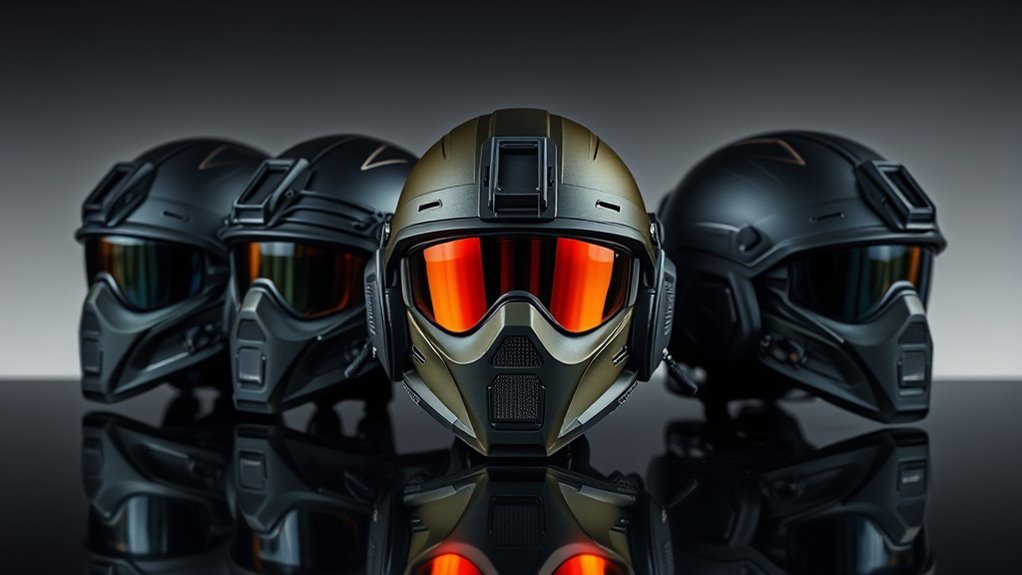
While maintaining a lightweight profile, special forces helmets are designed with advanced ballistic protection features that greatly enhance operator safety. These helmets are rigorously tested to meet various ballistic standards, guaranteeing they withstand high-velocity impacts. Helmet ratings are essential for determining the level of protection provided, with each rating corresponding to specific threats.
| Rating Level | Type of Threat | Impact Velocity |
|---|---|---|
| Level I | Handgun rounds | Up to 350 m/s |
| Level II | Shotgun pellets | Up to 400 m/s |
| Level III | Rifle rounds | Up to 900 m/s |
| Level IV | Armor-piercing rounds | Up to 1,000 m/s |
These features guarantee operators can perform missions with confidence in their protection.
Integrated Communication Systems
Integrated communication systems are essential for special forces operations, enabling seamless coordination and information exchange among team members. These systems facilitate tactical communication through advanced audio and data links, guaranteeing you stay connected in dynamic environments. With integrated headsets and microphones, you can transmit and receive critical information while maintaining situational awareness. The use of wireless connectivity eliminates cumbersome wires, allowing for greater mobility and flexibility during missions. Enhanced encryption protocols guarantee secure communications, protecting sensitive information from enemy interception. By leveraging these technologies, you can coordinate maneuvers, share intelligence, and respond effectively to evolving threats. Ultimately, integrated communication systems empower you to operate efficiently, fostering a cohesive team dynamic essential for mission success.
Night Vision and Augmented Reality Technologies
In modern special forces helmet designs, integrating night vision technology enhances operational effectiveness in low-light environments. Augmented reality capabilities further elevate situational awareness by overlaying critical information directly onto the user’s field of view. Effective user interface design is essential to guarantee seamless interaction with these advanced systems, allowing for quick decision-making in high-stakes scenarios.
Night Vision Integration
Modern special forces helmets increasingly incorporate night vision integration, merging advanced night vision technologies with augmented reality (AR) capabilities. This integration provides you with significant tactical advantages in low-light environments. By utilizing cutting-edge night vision technologies, these helmets enhance your situational awareness, allowing you to detect threats and navigate effectively in darkness. The lightweight optics and streamlined design guarantee that you maintain agility while benefiting from superior visibility. Furthermore, the ability to seamlessly shift between night vision modes can be essential during operations, giving you the edge over adversaries. With these advancements, you’re not just equipped to see in the dark; you’re empowered to execute missions with confidence and precision, preserving the freedom you fight to protect.
Augmented Reality Capabilities
Advancements in helmet technology have led to the incorporation of augmented reality (AR) capabilities alongside night vision systems. These innovations enhance situational awareness, allowing you to visualize critical data directly within your field of view. AR overlays can display maps, enemy locations, and mission objectives, providing tactical advantages during operations.
Additionally, the integration of immersive training simulations prepares you for real-world scenarios, improving decision-making and reaction times. With AR, you can practice in environments that closely mimic actual missions, fostering better readiness. This combination of night vision and augmented reality not only enhances performance but also promotes autonomy in high-stakes situations. As these technologies evolve, they empower you to operate more effectively, ensuring safety and mission success.
User Interface Design
While the integration of night vision and augmented reality technologies considerably enhances operational capabilities, the user interface design plays an essential role in ensuring these tools are effective and intuitive. You need to prioritize user experience by adhering to key design principles that enhance usability. Clear visual hierarchies, minimalistic displays, and responsive controls are crucial for quick decision-making in high-stress environments. The interface should provide real-time data without overwhelming you, ensuring critical information is readily accessible. Incorporating tactile feedback can further improve interaction, making it easier to navigate through various functionalities. Ultimately, a well-designed user interface empowers you to utilize advanced technologies effectively, contributing to mission success while maintaining the freedom to act decisively under pressure.
Comfort and Fit Enhancements
As you navigate the demanding environments of special operations, comfort and fit are essential for maintaining focus and performance. Modern special forces helmets utilize advanced padding materials designed to provide superior cushioning while minimizing pressure points. These materials often include breathable foams and moisture-wicking fabrics, guaranteeing you stay comfortable during extended missions. Adjustable straps are another critical feature, allowing you to tailor the helmet’s fit to your head shape and size. This customization helps distribute weight evenly, reducing fatigue and enhancing stability, especially during dynamic movements. A well-fitted helmet not only protects you but also contributes to your overall operational effectiveness. Prioritizing comfort and fit enhancements guarantees you’re prepared to face any challenge with confidence and agility.
Customization and Modular Designs
Customization and modular designs play an essential role in enhancing the functionality of special forces helmets. You’ve got the freedom to tailor your helmet to meet specific mission requirements, ensuring peak performance. Various color schemes allow for effective camouflage and adaptability to different environments, whether you’re operating in urban settings or natural landscapes. Additionally, numerous accessory options—like night vision mounts, communication systems, and ballistic visors—enable you to personalize your gear for efficiency and safety. This modular approach not only enhances operational capabilities but also promotes ease of use and quick adjustments in the field. By integrating these elements, you’re equipped to face diverse challenges while ensuring your helmet meets your unique needs.
Frequently Asked Questions
How Do Special Forces Helmets Compare to Standard Military Helmets?
Special forces helmets often outperform standard military helmets in several ways. You’ll find they incorporate advanced helmet features like enhanced ballistic protection, lightweight materials, and integrated communication systems. These helmets are designed for adaptability, allowing for mounting accessories like night vision goggles or tactical lights. The focus on situational awareness and comfort means they offer better fit and functionality, essential for the demanding environments special forces operate in, compared to more general military helmets.
What Is the Average Lifespan of a Special Forces Helmet?
The average lifespan of a special forces helmet typically ranges from five to ten years. This durability hinges on various factors, including exposure to environmental elements, maintenance routines, and the intensity of use. Just like a knight’s armor, your helmet must withstand wear and tear while providing maximum protection. Regular inspections and adherence to manufacturer guidelines can help guarantee it remains effective throughout its service life. Always prioritize safety over time’s wear.
Are Special Forces Helmets Used in Civilian Applications?
Yes, special forces helmets are used in civilian applications. Many outdoor enthusiasts, law enforcement, and security personnel adopt these advanced helmets for their durability and protective features. Civilian adoption often includes helmet modifications, such as adding communication systems or night vision mounts. These enhancements make them versatile for various situations, ensuring safety and effectiveness in high-stakes environments. Consequently, the design and technology originally intended for military use are increasingly relevant for civilian purposes.
How Do Helmets Impact Overall Mission Effectiveness?
Helmets notably impact mission effectiveness by enhancing protection and situational awareness in various mission scenarios. They’re designed to mitigate injury from ballistic threats and blunt trauma, which are essential impact factors. You’ll find advanced materials and technologies in modern helmets that improve comfort and communication, allowing for better coordination among team members. Ultimately, a well-designed helmet not only safeguards you but also boosts your operational efficiency, increasing the chances of mission success.
What Maintenance Is Required for Special Forces Helmets?
To guarantee your helmet remains effective, regular maintenance is essential. Don’t underestimate the importance of helmet care; it can markedly impact performance. Start by inspecting for cracks or dents, cleaning the exterior with mild soap, and avoiding harsh chemicals. Check the straps and padding for wear and tear, replacing them as needed. Following these maintenance tips will extend the helmet’s lifespan and maintain its protective capabilities, assuring you’re always ready for action.
